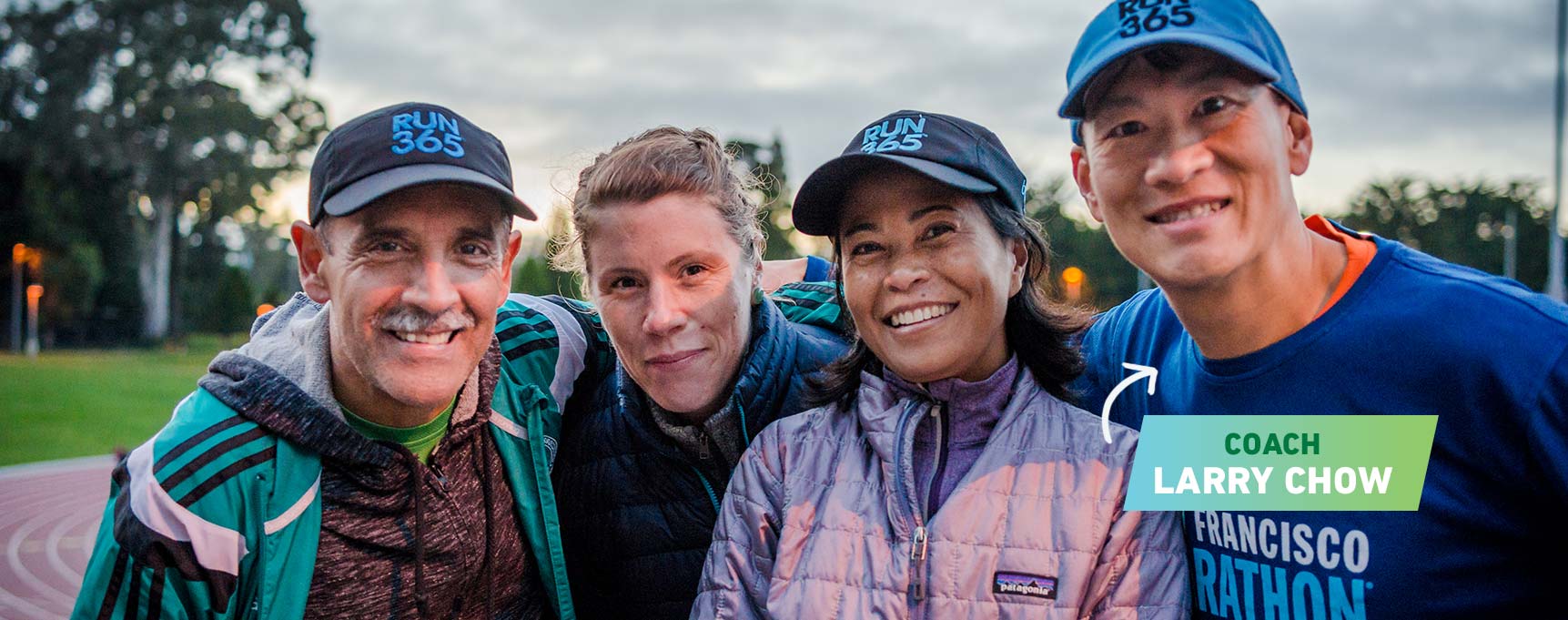Ask A Coach: Half Marathon Training Tips from Coach Larry Chow
Whether you’re well into your training plan or just getting started you might want a little extra help beyond the boost of confidence that your “lucky training socks” provide (you DO have lucky training socks, right?).
Getting some advice from an expert, like an experienced distance runner or running coach, can give you the skills, strength, and confidence you need to run a half-marathon. We chatted with Larry Chow, a USATF/RRCA-certified coach who has coached for RUN365 for 3 years, about his best half-marathon training tips for runners at every level.
With 20 years of fitness running and 5 years of marathon running under his laces, Larry has picked up more than a few tips for new and experienced runners. He’s quick to note that getting in race shape can vary from person to person, depending on their starting fitness levels, running experience, and commitment to training, but runners can be race-ready in as few as 8 weeks or as many as 18.
Larry’s half marathon training tips for experienced runners:
Be smart about distance: If you’re already used to running long distances and have a few marathon medals in your collection, you should still train for a half marathon. Is your formula as simple as “just run less?” Sort of, Larry says. “Training mileage is less, but cardio, strength training, and rest are still equal for both half and full marathons.” He recommends the 6-10 rule if you’re tapering from marathon length runs to train for a half marathon: run 6 or 10 miles every other week for your long runs, and make sure to maintain your strength training and speed workouts.
Train consistently and creatively: Even if you’ve run a marathon or half marathon distance fairly recently, you still need to train to stay in peak condition. For those planning to run the Biofreeze Berkeley Half Marathon after finishing the Biofreeze San Francisco Marathon this summer, Larry cautions that keeping up with training is very important. He explains that even if you’re used to distance running, your body doesn’t stay in race shape without a little work–VO2 max (the max amount of oxygen your body uses during exercise) and fitness levels can plummet in as little as 10 days without sufficient physical activity. You can, and should, still rest after a marathon, but know that a long training break will affect your fitness and performance in your next race.
Got a PR in your sights? Follow these tips:
Say you’re a distance runner who’s finally ready to level up your half marathon training so you can breeze right past your last time and hit a personal record come race day. Larry advises ambitious runners to follow these four key tips.
- Start doing long training runs at Goal Pace (a coach can help you figure out what this should be if you don’t already have one in mind) to get used to the tempo and speed.
- Train on courses or routes as similar as possible to the actual race course in advance. This is a key, yet unexpected secret of super-prepared runners.
- Ramp up your speedwork and cardio. Two times a week, you should be doing a track workout, tempo run, or HIIT boot camp style workout. Mixing up your fitness routine will work and train different muscles, increase leg and core strength, and help with your endurance–all necessary steps for you to hit your best time yet.
- Don’t neglect nutrition: while you’re training, eat a diet low in saturated fats and high in lean protein and complex carbs, especially for race day. This will provide the long-lasting source of fuel your body needs for an exceptional performance.
Larry’s half marathon training tips for beginning runners or new distance runners:
Prepare (and prepare to amaze yourself): If you’re a regular runner, but you’ve never officially raced or have stuck to 5Ks and 10Ks, a half marathon might sound daunting. Don’t be intimidated, Larry says. “A half marathon is equal to four 5Ks or two 10Ks,” and if you can run those distances regularly, an 8 week half marathon plan should work just fine for you.
Plan your pace: The training pace for your first half marathon depends on two things: your fitness, and your goals. Larry advises half marathoners that their training pace should be about 20-30 seconds faster (per mile) than full marathon training pace, but about a minute slower than a 5K or 10K training pace. If that’s too much math to do while you’re on the run, know that ideally, Larry says the long run training pace should be just below your lactic threshold, putting you at a heart rate between 120-140 beats per minute.
Cross train like your race depends on it: If you’re not accustomed to longer distances or races, you may have done just fine without a cross training routine so far. Oh, future half marathoner, those days are over! Larry recommends supplemental cross training and active recovery cross training to help get you into peak shape. “Supplemental cross training includes strength training, cardio HIIT Bootcamp type workouts, while active recovery cross training includes yoga, Pilates, cycling or swimming.”
Finally, if you’re running any of the Biofreeze Berkeley Half Marathon events this year, make sure to enjoy yourself! Larry reminds us why this is such a standout race: “The Berkeley Half Marathon is very special since it’s the only distance race of the year in a truly special town–one that has shaped culture and civil rights in America.” Runners, spectators, and race staff can certainly agree that the energy and excitement on this course is infectious, unique, and meaningful. We hope you’ll be there to experience it too, whether you’ll be volunteering, cheering, or running a race of any distance.

